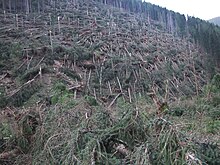Broken tree
Tree broken or tree litter is called overturning of a tree or large parts of it.
The typical causes of tree thrown are wind thrown from strong winds, snow break from heavy snow events or ice break from freezing rain , or avalanche , but also from loosening of the ground after frost, from water or geophysical causes such as mass movement . In addition, trees throw off parts that have become useless as natural clearing, even without any particular external effect, and gradually collapse due to illness or old age. This mainly concerns natural deadwood degradation, i.e. wood destruction by organisms such as wood rot (fungal infections) and insects and the like , and progressive mechanical damage ( material fatigue of the wood). Pre-damaged trees naturally fall much more easily in extreme events than vital specimens. However, the risk of breakage also depends on growth factors (vigor, location) and the type of tree .
- See also: Forest damage - forest-ecological focus on entire tree populations
In terms of forestry, a distinction can be made between:
- Broken roots - the tree falls together with the rhizome because the holding roots fail; Shallow root with a typical set up tree disc (central shallow root)
- Stick break - the tree breaks at the base (a tree stump / stick remains )
-
Trunk breakage - the main trunk fails, even at a great height above the ground
- These three forms are also called tree break in the strict sense of the
- Throwing a tree in the true sense of the word , breaking off branches , especially at the branch connection
However, this special distinction between the terms “tree break” and “tree throw” is not common. In another usage, for example, one speaks more specifically of 'windbreak' for branch and trunk breaks, and 'windthrow' for completely uprooted trees.
Large-scale tree breakage due to extreme weather is typical forest damage . In populated areas, consequential damage caused by tree breakage is a legal issue; the owner of a tree is generally obliged to take certain precautions (control, tree care ) and is liable for damage unless there is force majeure . This applies in particular to public spaces ; this traffic safety obligation also applies - with certain restrictions - in the forest. In the event of negligence , there may be problems with liability insurance .
literature
- Claus Mattheck, Helge Breloer: Handbook of damage science of trees. The broken tree in mechanics and jurisprudence. 2nd edition Rombach, Freiburg im Breisgau 1994 (legal focus on Germany).
Web links
Individual evidence
-
^ Helmut Mayer: Tree vibrations and the risk of storms in the forest. Volume 51 of Wissenschaftliche Mitteilungen , Meteorological Institute (series of Munich University Writings ) 1985, S 74, 109 f; also:
H. Mayer, D. Schindler: Forest meteorological principles for triggering storm damage in the forest in connection with the hurricane "Lothar". In: Allgemeine Forst und Jagdzeitung , Volume 173 (2002), pp. 203 f (full article pp. 200–208). - ↑ See Trees & Law (baeumeundrecht.de): List of publications.









